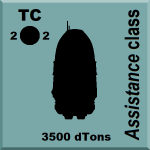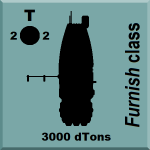Assistance class Commercial Tender
| Assistance class Commercial Tender | |
|---|---|
 AAB Ship Reference File. | |
| Type: TC Commercial Tender | |
| Category | BCS |
| Size | 3,500 Tons |
| Hull Configuration | Cone Hull |
| Streamlining | Streamlined Hull |
| Tech Level | TL–11 |
| Engineering | |
| Computer | Model/3 |
| Jump | J-2 |
| Maneuver | 2 G |
| Armaments | |
| Hardpoints | 35 |
| Accommodations | |
| Staterooms | 0 |
| Personnel | |
| Crew | 62 |
| Officers | 12 |
| Enlisted | 28 (+22 Technicians) |
| High/Mid Passengers | 0 |
| Payload | |
| Cargo | 66.0 Tons |
| Fuel tank | 0 Tons |
| Construction | |
| Origin | Unknown |
| Year Operational | Unknown |
| End of Service | Still in active service |
| Price | |
| Cost | MCr1,626.848 (base) MCr1,301.479 (qty) |
| Architect fee | MCrAde Stewart |
| Statistics | |
| Quick Ship Profile | TC. |
| Images | |
| Blueprint | No |
| Illustration | Yes |
| Source | |
| Also see | Tender |
| Canon | Published, fan design |
| Era | 1105 |
| Starships are designed with the Classic Traveller format, using Book 5 High Guard | |
The Assistance class Commercial Tender is a large Industrial Vessel.
- It is a Civilian Ship and a Tender.
- It is a repair ship.
- The class is used as a rescue vessel.
Description (Specifications)
The Assistance class is a large repair ship. It provides commercial repair and maintenance services, typically in systems where the starport does not offer such facilities.
- The vessel is a TL-11 design.
These large ships may be encountered almost anywhere. Their outer skins frequently exhibit dents and dings resulting from poor maneuvering while vessels are docking and often have patches and repairs done by their own crews. Commercial tenders may serve an organisation, supporting its operational craft and providing them with maintenance in remote locations, or may operate as independent support vessels, offering on-the-spot maintenance, particularly in systems with starports that do not provide repair amenities. Military tenders will generally be accompanied by at least one escort vessel.
Image Repository
Assistance class Commercial Tender

General Description
The Assistance class is an auxiliary tender with performance of J-2 and 2-G acceleration. It is a relatively large, relatively slow ship, equipped with strong sandcaster defenses and laser turrets most commonly used in a point defense role. The design is fully streamlined, giving good atmospheric performance, allowing it to skim for fuel, and enabling it to perform surface landings.
The vessel is an unevenly shaped cone with an overall length of 102 meters, a mean diameter of 42 meters, and a volume of approximately 47,250 cubic meters. The ship has many pods, blisters, cowlings, recesses, housings, and protuberances over its surface. Despite this slightly irregular shape it is aerodynamic and may operate within planetary atmospheres.
Basic Ship Characteristics
Following the Imperial Navy and IISS Universal Ship Profile and data, additional information is presented in the format shown here. The small craft factor indicates the number of squadrons (...of ten subcraft) carried on the ship. Tonnage on the universal ship profile is shown in kilotons (...thousands of tons) where necessary. [1]
| Basic Ship Characteristics [2] | ||
|---|---|---|
| No. | Category | Remarks |
| 1. | Tonnage / Hull | The Assistance class Commercial Tender is constructed using a 3,500 dTon hull built in a generally conical configuration. The hull is fully streamlined, giving good atmospheric performance that is further enhanced by its onboard gravitic systems.
|
| 2. | Crew | x62 personnel (x70 in military service).
Accommodations There are 60 Staterooms.
There are x20 Low Berths.
Accessible areas of the hull are fitted with grav plates and inertial compensators and have full life support and environmental systems.
|
| 3. | Performance | The vessel mounts a Jump-2 drive, a Maneuver-2 drive, and a Power Plant-2, giving performance of Jump-2 and 2-G acceleration. The ship has an agility rating of 2. The internal fuel tankage is sufficient for one Jump-2 and gives the power plant 4 weeks duration.
|
| 4. | Electronics | Adjacent to the bridge is a Model/3 computer. A backup Model/3 is installed in engineering.
The vessel is fitted with communications equipment, a standard sensor array, and has an avionics suite.
|
| 5. | Hardpoints | x35 hardpoints.
|
| 6. | Armament | The normal weapons fit-out for a Assistance class is:
|
| 7. | Defenses | The hull is unarmored.
|
| 8. | Craft | Commercial Hangers
Internal commercial hanger space amounts to 1300 dTons.
Flight Section The two subcraft are housed in dedicated individual hangars: the hangars can be sealed. Each has a volume of 15 dTons. |
| 9. | Fuel Treatment | The vessel has internal fuel tankage of 770 dTons.
The vessel has commercial / refuelling tankage of 500 dTons. |
| 10. | Cost | The basic cost of the vessel is MCr1,622.366
The price does not include the cost of the subcraft:
With its subcraft, a discounted Assistance class costs MCr1,307.749 |
| 11. | Construction Time | 137 as standard, 110 weeks in quantity.
|
| 12. | Comments | Standard cargo capacity amounts to 4 dTons.
|
History & Background (Dossier)
The design is representative and large numbers of variants exist, particularly with regard to the installed weapons systems, the allotted onboard electronics, and the fit out of accommodations and internal spaces.
- Assistance class Tenders often pair with a Furnish class Tanker.
- These two vessels, working together, can temporarily provide some equivalence to Class A starport facilities on a frontier world.
Class Naming Practice/s & Peculiarities
Vessel Peculiarities:
The design is capable of independent operations (it can provide its own fuel) and can transport incidental supplies in its hold.
The hangars are designed to conduct repair and maintenance on spacecraft and starships. They have conventional machine ships, cutting and welding gear, mechanical and gravitic lifting equipment, computer-assisted design and 3D printing facilities, stationary robotic manufacturing units able to construct complex specialist components, stocks of fluids and gases and consumables (such as 3D print base material, sealants, or abrasives), and a wide range of tools and specialist maintenance equipment.
- The hold is most commonly used to store parts, components, and fittings.
- Additional spare parts are typically stored in unused hangar space.
A number of examples of the class have been used as "base ships" by pirate groups.
Class Naming Practice/s:
Individual vessels are generally named by the organization that operates them. This is considered a serious affair and a ship with a frivolous name is considered "unlucky". Spacefarers tend to be superstitious and such vessels may find that they attract less commercial interest or are less favored for berthing slots, further adding to their unlucky reputation.
- Individual vessels are issued specific serial numbers and transponder codes.
Selected Variant Types & Classes
References & Contributors (Sources)
| This article has metadata. |
- Marc Miller, Frank Chadwick, John Harshman. High Guard (Game Designers Workshop, 1980), 20-37. (Design Sequence Used)
- Author & Contributor: Lord (Marquis) and Master Scout Emeritus Adie Alegoric Stewart of the IISS
- ↑ Timothy B. Brown. Fighting Ships (Game Designers Workshop, 1981), 10.
- ↑ Timothy B. Brown. Fighting Ships (Game Designers Workshop, 1981), 10.

